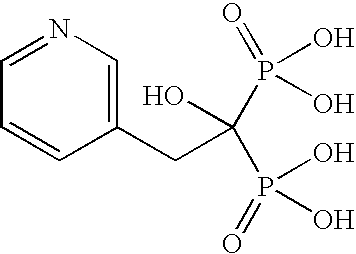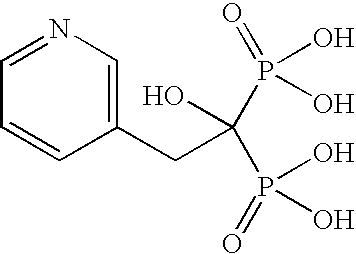Process for the Preparation of Risedronate Sodium
a technology of risedronate and sodium, which is applied in the field of process for the preparation of risedronate sodium, can solve the problems of not providing the data concerning the manufacture of risedronate, too complicated operations to be carried out in a large scale, and not providing the final product of suitable purity, etc., and achieves high purity and high yield.
- Summary
- Abstract
- Description
- Claims
- Application Information
AI Technical Summary
Benefits of technology
Problems solved by technology
Method used
Image
Examples
example 1
Preparation of Risedronic Acid
[0071]3-Pyridyl acetic acid hydrochloride (25.0 g), phosphorous acid (35.42 g) and n-octane (300 ml) were taken in a reaction flask and heated at 90-95° C. for 30 minutes. The reaction mixture was cooled at 50-60° C. followed by addition of oxalyl chloride (109.66 g) and further heated at 90-95° C. and maintained for 3 hours. The reaction mixture was cooled at 25-30° C. followed by the addition of water (125 ml). The reaction mixture was heated at 90-95° C. The reaction mixture was then cooled at 55° C., which is then followed by the addition of methanol (250 ml). The reaction mixture was cooled at 0-5° C. The precipitated solid was filtered, washed with methanol and then dried to produce 25 g of risedronic acid (HPLC Purity: 99.5%).
Level of organic volatile impurities: n-octane—not detected, and methanol 590 ppm.
example 2
Preparation of Risedronic Acid
[0072]3-Pyridyl acetic acid hydrochloride (100 g), phosphorous acid (188.94 g) and n-octane (700 ml) were taken in a reaction flask and heated at 85-90° C. for 30 minutes. This was followed by the drop wise addition of phosphorous oxychloride (353.29 g) at 85-90° C. and the resulting mixture was stirred for 3-4 hours at the same temperature. The resulting mass was cooled to 70-75° C. followed by the drop wise addition of water (50 ml) and then stirred for 20-30 minutes. This was followed by the addition of water (650 ml) in 30-40 minutes and the resulting mixture was heated to 85-90° C. and maintained for 12 hours. The resulting hot reaction mixture was filtered through hyflow bed and washed with hot water (100 ml) followed by the addition of methanol (1400 ml) at 30-50° C. in 30-40 minutes. The resulting mixture was cooled to 0-5° C. and then stirred for 1 hour. The resulting solid was filtered, washed four times with water (300 ml×4) and then dried th...
example 3
Preparation of Risedronate Sodium Hemi-Pentahydrate
[0073]Risedronic acid (10 g, obtained in example 2) was suspended in water (100 ml) followed by the addition of a solution of 2-ethylsodium hexanoate (6.87 g) in water (25 ml). The resulting reaction mixture was heated at 60-65° C. to form a clear solution followed by the addition of isopropyl alcohol (250 ml) at the same temperature. The resulting suspension was cooled at 25-30° C. for 3 hours. The resulting white colored solid was filtered, washed with isopropyl alcohol (20 ml) and then dried under vacuum at 40-45° C. to produce 10 g of risedronate sodium hemi-pentahydrate (HPLC Purity: 99.9%; LOD: 11.9 to 13.9).
Level of organic volatile impurities: methanol—540 ppm, isopropyl alcohol—175 ppm and n-octane—not detected.
PUM
 Login to View More
Login to View More Abstract
Description
Claims
Application Information
 Login to View More
Login to View More - R&D
- Intellectual Property
- Life Sciences
- Materials
- Tech Scout
- Unparalleled Data Quality
- Higher Quality Content
- 60% Fewer Hallucinations
Browse by: Latest US Patents, China's latest patents, Technical Efficacy Thesaurus, Application Domain, Technology Topic, Popular Technical Reports.
© 2025 PatSnap. All rights reserved.Legal|Privacy policy|Modern Slavery Act Transparency Statement|Sitemap|About US| Contact US: help@patsnap.com


